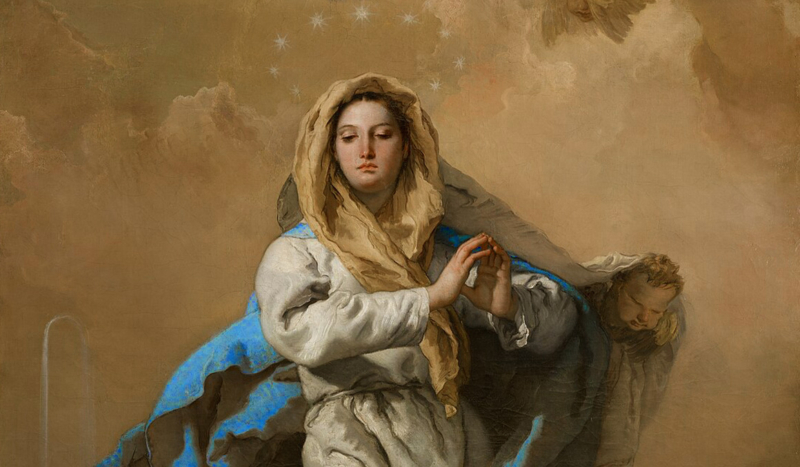
The Immaculate Conception / Giovanni Battista Tiepolo
CV NEWS FEED // The Solemnity of the Immaculate Conception, celebrated Dec. 8, honors the Blessed Virgin Mary’s sinless conception — a doctrine affirmed not only through infallible teaching but also through Mary’s own apparitions to saints throughout history.
The Solemnity of the Immaculate Conception is a holy day of obligation. The liturgical color for the feast is white, signifying Mary’s purity and freedom from original sin. The day’s Mass readings reflect this theme; Genesis 3:9-15, 20 highlights the fall of humanity and the promise of redemption, while Luke 1:26-38 recounts the Annunciation, when Mary humbly accepted her role as the Mother of Christ.
This significant teaching of the Catholic Church was defined as dogma, which is doctrine infallibly taught to be divinely revealed, by Pope Pius IX in 1854 through the papal bull Ineffabilis Deus after centuries of theological debate and reflection on the Scriptures and the nature of grace.
Historical Development of the Dogma
Although the Bible does not explicitly mention the doctrine of the Immaculate Conception, many theologians have interpreted the angel Gabriel referring to Mary as “full of grace” to mean that she was sinless from the very beginning.
Throughout the medieval period, the debate surrounding Mary’s Immaculate Conception was contentious. While some regions in Western Europe began celebrating the feast, Rome did not officially endorse it, leading to opposition from prominent theologians, including St. Bernard of Clairvaux and St. Thomas Aquinas.
Blessed John Duns Scotus, a Franciscan scholar, provided a significant theological defense of the doctrine. He argued that Mary’s preservation from original sin highlighted her unique role in salvation history without diminishing her dependence on Christ.
By the late Renaissance and into the modern era, acceptance of the Immaculate Conception grew. The Council of Basel in 1431 recognized Mary’s sinlessness as a special gift from God and deemed the belief both “pious and agreeable to the worship of the Church.”
Later, Pope Sixtus IV permitted the feast to be celebrated in Rome in 1477, and Pope Clement XI extended its observance to the universal Church in 1708.
The acceptance of the Immaculate Conception as a doctrinal truth was especially popular in imperial Spain, where Our Lady was referred to as “La Purissima” (the Most Pure). On Dec. 8, 1585, a miracle attributed to the Immaculate Conception allowed the Spanish troops to avoid a bloody defeat during the Battle of Empel in Holland.
Consistent with the devotion, many famous Spanish artists, such as Diego Velázquez and Francisco de Zurbarán depicted Mary under the advocation of the Immaculate Conception centuries before the proclamation of the dogma.
Across the Spanish Empire, from Hispanic America to the Philippines, 160 places in 21 countries were named “Concepción” in honor of the Immaculate Conception.
Pope Pius IX’s Declaration
The 19th century was pivotal for the definition of the Immaculate Conception. In 1830, the Blessed Virgin Mary appeared to St. Catherine Labouré, revealing the “Miraculous Medal” with the inscription, “O Mary, conceived without sin, pray for us who have recourse to thee.” This sacramental further affirmed Mary’s sinlessness and the truth of the Immaculate Conception.
In 1846, U.S. bishops meeting in Baltimore designated the Virgin Mary in the advocation of the Immaculate Conception as the patroness of the United States. According to the official site of the United States Conference of Catholic Bishops (USCCB), “the Blessed Mother, under the title of the Immaculate Conception, has been a patroness of the United States since 1846. She was chosen as such because of the common devotions to Mary (especially as the Immaculate Conception) that many ethnic groups brought when they came to the United States, an immigrant country.”
The decision was later approved by Pope Pius IX. This growing devotion set the stage for the dogmatic declaration.
In 1854, Pope Pius IX proclaimed the dogma of Mary’s sinlessness without convening an ecumenical council. He had previously solicited feedback from bishops, religious orders, and laity and had received overwhelming support.
The dogma states:
“We declare, pronounce, and define that the doctrine which holds that the most Blessed Virgin Mary, in the first instance of her conception, by a singular grace and privilege granted by Almighty God, in view of the merits of Jesus Christ, the Savior of the human race, was preserved free from all stain of original sin, is a doctrine revealed by God and therefore to be believed firmly and constantly by all the faithful.”
The validity of Pius IX’s declaration was affirmed just a few years later when Mary appeared to St. Bernadette Soubirous at Lourdes in 1858, declaring, “I am the Immaculate Conception.”

